I saw a post today where someone described a couple of tricks that Noise can do with Workshop as “cute”. Workshop isnt good in Noise for just one reason. No one reason alone is probably worth paying 4 influence for it (though maybe the economy and help dealing with Wyldside draws would be worth it, by themselves).
Its the combination of many synergies that makes Workshop into a monster for the Noise deck.
So I decided to create a list of 12 different “cute” things that Personal Workshop does for the Noise player.
Because Personal Workshop is so good, that it goes up to 12!
1) Provides Economy.
Workshop gives $1 a turn, in discounts. That’s huge. People play Underworld Contacts, a card that costs $1 more, and requires getting another specific card in order to to work (link), in order to get $1 a turn. $1 a turn for a low investment is amazing. Sure, its not an all-purpose credit. But given how often Noise is installing things, its pretty much like a real credit.
2) The Wyldside Problem.
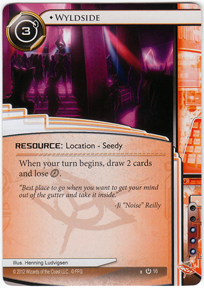
Provides a way for the Wyldside player who has managed to draw lots of programs/viruses/etc., but not drawn economy cards, to actually afford to play those cards, instead of simply discarding them wastefully. Previously Anarch could run into ‘the Wyldside problem’, where you draw 2 cards a turn and have 3 clicks to use them. If they all cost money, you just can’t play them all, so you were screwed if some of them weren’t economy cards. But now, if you draw Workshop, this problem is no longer there. (Unless you play against NBN. You can’t just stack all the things on a workshop vs. NBN, with no money, because of Breaking News. Try to not load your workshop with more things that you can immediately afford to buy off it if you get tagged, vs. NBN).
3) Synergy with Stimhack.
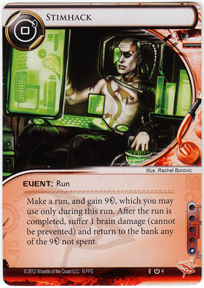
Workshop turns Stimhack from a card that lets you make a hard run when broke, to a card that provides way, way more money than sure gamble, at the cost of a brain damage. You can use the $9 provided to pay for things on the workshop, even if your run ends up stopped by a Wall of Static. Not only that, but it’s a $9 providing card that, if you wanted to make a run, also provides the click for the run. What does a Wyldside deck really want? It really wants strong burst income, so that for 1 click, it can afford to pay for many cards, since they keep flooding in. Stimhack + Workshop provides this.
4) Instant Parasites.
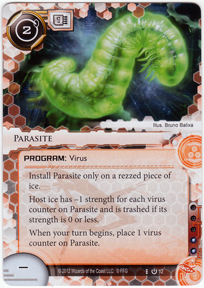
Parasite is an amazing card, but it has to be placed onto REZZED ice. This means that, barring forged activation orders, it has to be placed onto an ice that you’ve already encountered once, and have suffered the effects of, or have paid to break. So the ice already at least provided SOME gain for the corp. With workshop, once the ice is rezzed during a run, you can instantly plop a parasite on it, Datasucker it down, and kill it before it ever hurts you in any way! This is a significant efficiency gain for parasite.
Note also that this allows for a ‘double counter parasite’. At the end of the corp turn, pull Parasite off workshop, with Grimoire in play. It comes in with 1 counter, then another appears at the beginning of your turn. What do you gain from this, that you couldn’t have gotten by playing it on your turn? Well, if you play the parasite, and they decide to wipe viruses that turn, you’re down 1 counter. (Presumably, they wiped due to other viruses, and your one parasite counter was merely an extra casualty). Secondly, its more surprising. When you parasite on your turn, the corp might see the coming weakness you are hoping to create in that server, and take the time to add another piece of ice there. But the end of turn parasite, followed by collecting enough Datasuckers and blowing that ice away on your next turn, is faster. You might get multiple hits of a newly undefended server to build up a Medium or Nerve Agent with. You basically got one bonus turn of parasite buildup, without having committed to where it was going or telling that information to the corp!
5) Protected virus counters, safe from Purging.
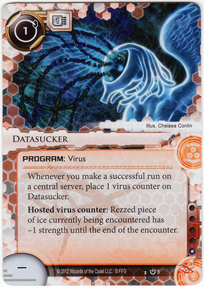
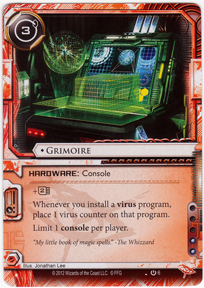
Normally, if you want to use virus programs, you play them out, and if you get too many of them, the corp will purge virus counters. This reset s all your previously played viruses back to zero power, all at once. However, if you have a Grimoire, and viruses are sitting on a Workshop, those viruses are ‘almost in play’ with 1 virus counter on them. They can appear at will with 1 counter already available. So that means that a Datasucker sitting on a workshop can appear and give you 1 strength reduction when needed. If the corp purges, this ‘counter’ does not go away. But a Datasucker sitting in play with 1 counter on it, will lose its counter when everything is purged.
Alternately, it also means that a Crypsis sitting on the Workshop has one, unpurgable, virus counter.
6) The Power Turn.
One of the things about playing Anarch is that you tend to be action constrained. Wyldside is awesome, but while it’s in play you’re down a click each turn. The nature of viruses is that, when built up, they are very powerful, but all of that power can be wiped out at once by the corp purging viruses. This forces you to do a re-buildup, which can take a bit of time. (Putting counters on Crypsis again to be able to run, building up datasuckers, rebuilding that medium).
Anarchs are all about maximizing the effect of that ‘power turn’, where all their viruses are full and you haven’t had a chance to purge yet. (Because you were broke from a Vamp, or too poor to rez ice on the fort you need to defend).
Without Workshop, you might have these turns where you want to put a Parasite onto ice, play a datasucker, run archives for a datasucker counter, then run the ice and kill it. Now you blew a hole in their R&D defense. If you had more clicks, you could then smash R&D with a medium, but you don’t. The corp takes their turn and ices R&D again.
But with workshop, you do all of that stuff FASTER. You had already set up parasite and datasucker on the workshop in an earlier ‘prep turn’, so now, on the critical turn, they don’t cost a click. You can Run archives, plop the parasite and datasucker out, check the milled cards while getting your extra needed sucker counter, then run the R&D ice, kill it, and have more clicks to pound R&D with that medium.
Next turn, the medium is ALREADY BUILT UP, and R&D is exposed. If the corp places R&D ice, you force through that ice once with Crypsis and see many cards. If they purge viruses, you can just run R&D 4 times, getting medium and datasucker counters, and they are in a worse spot than before.
Anarchs live for the power turn, where viruses are powered up, and they still have actions remaining. Workshop helps by allowing you to spend clicks in ‘prep turns’, and then do more things in a power turn. You need to do as much as possible in the power turn, because once it’s over the corp can purge viruses.
7) Defense against Archived Memories.
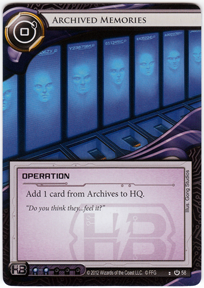
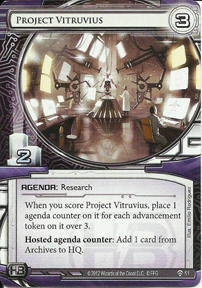
Without workshop, you will, over time, mill cards into the corp’s archives. If you don’t also repeatedly run archives (inefficient, unless unguarded and you have datasucker), then an HB corp can Archived Memories back a milled agenda, negating your benefit.
However, if you load all those viruses onto the workshop, and then run archives, and when you get through, power them all into play (possibly with Stimhack money), you immediately get to look at a bunch of milled cards, without giving the corp a turn to archive them.
To a lesser extent, it also defends against a Project Vitruvius counter. As first click, Noise runs archives, pays for 6 viruses. Before he accesses, HB player uses a Vitruvius counter and pulls the milled agenda into hand. Now, Noise player runs HQ for the rest of the turn, hopefully with Nerve Agent, and gets the agenda anyway.
Without workshop, this turn might go: Click 1: Play virus. Click 2: Play virus. Click 3: Play virus. Click 4: Run archives to check those cards (corp uses Vitruvius). Or alternately, they leave 1 click open, and get only one chance at running HQ for that agenda, not multiple. Note also how much more efficient it is to go on an archives run for 6 new milled cards, than less.
8) Delayed Payment.
Let’s say there are two unknown ice guarding R&D. I have 10 credits. I have Mediums and Datasuckers in my hand. I don’t know how many of these Mediums and Datasuckers I can afford to play before running, and still make it through the ice, since I don’t know what they are. But if I have them on a workshop, then I can run, and when I make it through the ice, I can see which programs I can afford to bring into play, before hitting R&D. So it’s like I always made the correct guess. Rather than playing both mediums first, leaving me with $4, and running into a something I can’t break and getting wrecked, I instead run, see that I have $3 left after getting through, and only buy one medium.
In the same way that getting delayed money is worse than up front money ( a drawback of Kati Jones for example, which balances out her increased efficiency), it is better to backload the payment of things. Workshop lets you pay for things as late as possible, and still have them when needed. No paying for Corroders and Yogs and stuff in advance in order to be prepared. Just buy them the instant you need them instead.
9) Reduced exposure to program trash effects.
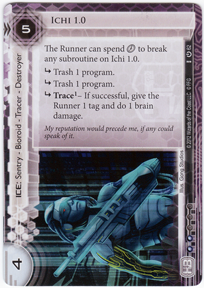
Normally, as soon as you install a program into play, you ‘turn on’ various ice effects that trash programs, such as Rototurret and Ichi. These ice, especially Ichi, suddenly become far stronger. Also, a good opponent will often not rez a Rototurret or Ichi if you have no programs in play, in order to not give it away.
With a Workshop, your programs can sit on the workshop until you actually need them, not at risk. For example, let’s say the corp builds a fort consisting of an Ice Wall, with an Ichi outside it.
If you play a Corroder or Crypsis to break the Ice Wall, and run, then Ichi will trash your breaker or at least burn 2 clicks or lots of money. If the breaker is trashed, Ice Wall stops you. If you don’t play the breaker, Ichi doesn’t get Rezzed, and Ice wall stops you.
But Workshop tricks its way through this server, the first time. When you come to Ichi, you have no program, so Ichi doesn’t get rezzed. Then Ice Wall is rezzed, you pull your Corroder off the workshop, and break it. You’re in. You snuck the program in mid-run, AFTER passing the Ichi!
10) More efficient Yog, Femme, Plascrete, etc.
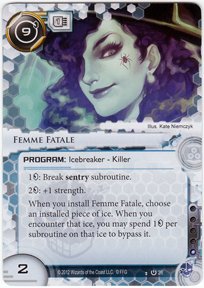
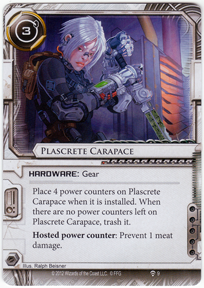
Yog wrecks low strength code gates. Since it completely nullifies them, once the runner plays Yog, the corp just won’t rez them. No money lost for corp.
If the runner runs into a codegate first, like Enigma, and is stopped, then plays Yog, then they burned $3 of the corp’s money. But they lost a click and had their run stopped.
Putting the Yog on a workshop gives the best of both worlds. If the corp never rezzes the ice, the runner never pays for the Yog. If the corp does rez, the runner can pay instantly and never suffer any bad effect from the code gate.
So essentially, with these cards and workshop, you either never have to pay at all, but still gain benefit, or you force the corp to pay like normal, but you avoid the standard bad effects you would suffer.
A similar principal applies to Femme Fatale. If you Femme a face-up ice, you had to suffer through that ice once first. Maybe that tollbooth ended your run and cost you $3, then you femme it. But if the femme is on the workshop, you pull it out instantly when the Tollbooth is rezzed, and you never suffer any bad effect.
Let’s say you instead play Femme and put its bypass on a face down ice. If you guess correctly and pick a big ice, something you want to femme, then the corp probably never pays for to rez it. They don’t ever lose the $8 for that tollbooth or $4+Agenda for that Archer. Only the instant speed femme both forces the corp to pay AND avoids ever suffering the ice’s effect.
Finally, Plascrete is normally a card that the runner will pay $3 for, in advance, against a corp they are scared of getting Scorched by. This cost is paid, even if the runner never ends up being tagged n the corp’s turn.
But with Workshop, you can sit the Plascrete on Workshop, and not pay for it, unless the corp tags you on his turn. If they never hit you with that Sea Source/Posted Bounty, or trick with into a last click Snare hit, you never lose the $3. But if they do, you still get to buy your Plascrete.
This principle is similar to the ‘delayed payment’ principal, but with the idea that you might not have ever needed to pay for the card in the first place, but instead you only pay for it if its really needed, and if the corp pays to do something first (like Sea Source you).
While generally a Noise Workshop deck wont play all of Yog, Femme ,and Plascrete, most lists I see at least play one of these.
11) The Power Dig.
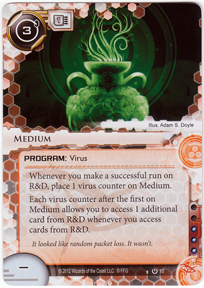
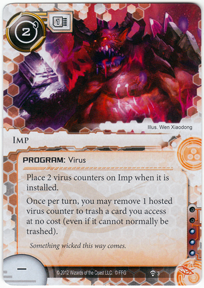
Related to the power turn, the combination of Workshop with Viruses, plus Medium, allows the Noise player to Medium dig the corp far harder in one turn, before giving the corp a turn, and thus a chance to purge viruses or improve defenses of a weak server.
For example, without Workshop, the Noise player plays a Medium, getting a counter with Grimoire. They run R&D three times and look at 2, 3, and 4 cards. If those cards aren’t trashable, that’s all they see. So some of the seen cards are duplicates, not new cards.
Now, they do the same thing, but with a Workshop which contains 2 Imps and another Virus.
The first R&D run, the noise player looks at 2 cards. The second R&D run, the Noise player, before accessing, brings both Imps into play, milling the two untrashable cards they looked at before. They now see 3 NEW cards. They Imp away any untrashable cards.
Now for the third R&D run, they see 4 cards. Because they imped away things that weren’t trashable, (and if all 3 weren’t, they bring out the other virus to mill the third), they are seeing 4 NEW cards. This medium dig turn resulted in far more new card accesses than the non-Workshop player.
Yes, the non-workshop player could’ve gotten mills off those same viruses, and trashed some R&D cards with those same Imps. However, he cant do this all on the same turn he is hitting R&D several times in, and if he had those Imps out on a previous turn, they probably would’ve resulted in a Virus Purge.
12) Targeted milling.
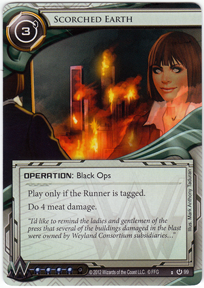
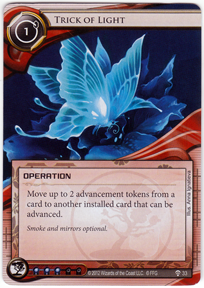
Let’s say that you are playing against Weyland, and really don’t want them drawing Scorched Earth, because them having access to it opens up potential problems.
You get out a Medium, and you dig them for three. You see that their upcoming cards are: Hedge Fund, Ice, and then Scorched Earth. But you don’t have an Imp right now, so you couldn’t Imp that Scorched Earth. Or maybe you ‘wasted’ your Imp once-a-turn on the Hedge Fund.
Now it is the Corp’s turn. The corp decides he needs to hunt for his Scorched Earth (or whatever), so he goes: Mandatory draw, draw again. (Or if the Scorch is just two cards down, just the mandatory draw). Right then, at that moment, between corp actions, you pull a virus off your Workshop! Bam, Scorched Earth into archives before he could draw it!
Without a Workshop, you couldn’t target your mill like this. On your turn if you play one you only hit the top card, you can’t just mill him at will on his turn, once he has drawn into a state where the Scorch is now on top of the deck.
The same idea works for preventing HB Fast advance from drawing its Trick of Light, or whatever other card you care about. Once you see multiple cards from a medium dig, and there is a ‘problem’ card in there, but not at the top, you can instant-mill it on the corp’s turn, as soon as they make the draw that brings it to the top of the deck!
Conclusion
Workshop gains its power from the accumulation of a large number of different ‘tricks’ and efficiencies it provides. While any one of them alone might be “cute”, and wouldn’t be worth including by itself, the net result is a powerful monster of synergies, abilities, and economic gain.
It’s a powerful tool in the Noise deck. Probably the most powerful. While the deck certainly can still win in games where it can’t draw a workshop, it’s definitely not as strong. Workshop does some of these things for other decks as well, like a typical Shaper deck. But it doesn’t do nearly as many awesome things in other decks as it does in Noise, where it interacts well with Viruses, Grimoire, and the Noise ability.
Noise Workshop is a difficult deck to play at a very high level, and has many, many opportunities for timing tricks and methods of increasing its attacking power. There is pretty much always room for improvement and perfection. I don’t play the deck perfectly at all, and I’ve been playing it a lot now, but I definitely can tell that I’ve improved with it over time.
Hopefully this article will help people see and learn more ways to use their Noise Workshop decks to higher effectiveness, or convince Anarchs to play this powerful card that synergizes so well with the Anarch Virus theme and the Noise ability. It’s not the only strong runner deck, but I am convinced that it, along with a strong Aggro Gabe deck, are the two top runner archetypes right now, at least among established decklists. (Who knows what Andromeda build we might all come up with in the future).





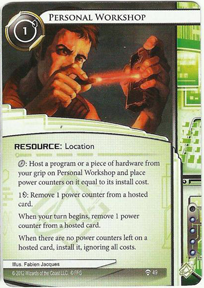
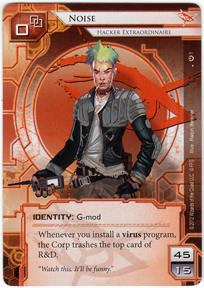
2 Comments: